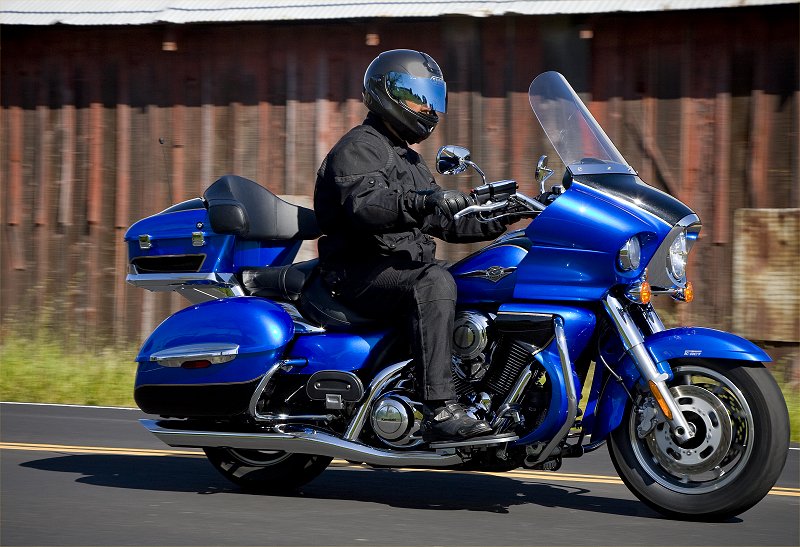
Vulcan 1700 Voyager
Press introductions for large-displacement cruisers aren’t quite what they used to be. Perhaps it’s ancient history now, but there was a time when larger cruisers had a single, largely inadequate front disc brake (and sometimes even a drum brake in the rear), squishy suspension, wallowy chassis and severely limited ground clearance. Press intros for these beasts involved a very orderly, pedestrian-paced, follow-the-leader-and-look-at-the-pretty-scenery ride. The contrast with a sport bike press introduction, where testosterone-fueled journalists frequently went into full race mode on the street, couldn’t have been more dramatic.
On the afternoon of my first day testing Kawasaki’s 1700cc Vulcan cruisers in Northern California a couple of weeks ago, the old style of cruiser press intro couldn’t have been further from my mind. At the time, I was aboard Kawasaki’s new Nomad, and I was chasing Kawasaki press representative Greg Lasiewski (riding two-up on the full dress Voyager) through a very twisty road that passes the front gate to producer George Lucas’ ranch. The road is known as Lucas Valley Road (not named for the famous Star Wars producer). I had purposely put myself at the head of the group of journalists I was riding with, right behind Greg, hoping for an opportunity to press the pace a bit on this fabulous road with its rhythmic turns and overhanging trees. When we were through, the rest of the journalists needed a minute or so to catch back up, but I think both Greg and I had big smiles plastered on our faces.
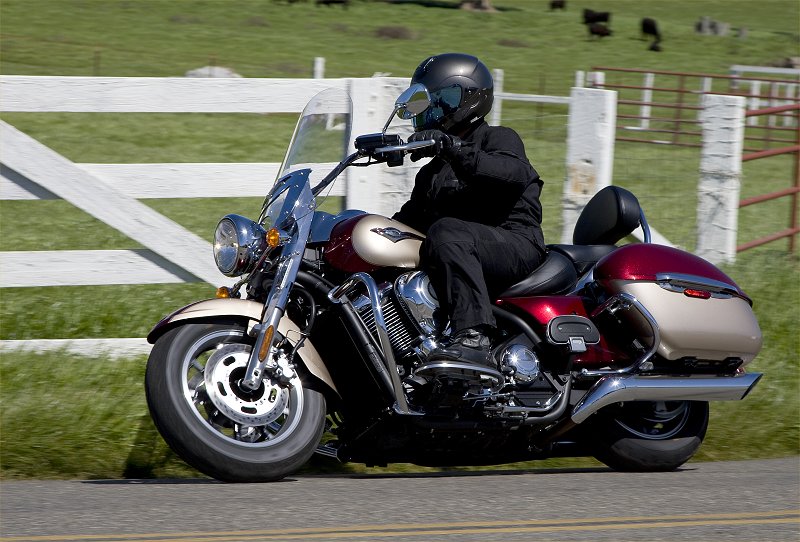
Vulcan 1700 Nomad
Had Greg been without a passenger, I know we could have gone a fair bit faster, but the pace we carried was already impressive aboard 1700cc, 800+ pound, traditionally styled v-twin cruisers. I have probably ridden other cruisers that quickly through the twisties (although not more than one or two other times), but never with so little drama. Trail braking into corners, tossing the big machine from one side to another when changing directions, and even casually noting just how much the floorboards were folding up in the corners (in order to avoid grounding something fixed), it was literally a walk in the park. “Confidence inspiring” is the catch phrase, but in retrospect, that would be an understatement given the size and the weight of the machinery we were aboard.
This little anectode might tell you more about where Kawasaki is coming from with its new Vulcan 1700 series than all of the somewhat tedious detail I am about to tell you. Kawasaki doesn’t mince words these days. The company is focused on performance, and the category involved doesn’t matter. Of course, competition is fierce among all of the motorcycle manufacturers, and the large displacement cruiser category presents some of the most stout competition of all. Kawasaki had their work cut out for them when trying to develop a line of motorcycles that stood out from the alternatives available to consumers. One way to do this, of course, is to introduce a machine with features simply unavailable anywhere else.
Kawasaki has tried to do that with the new full dress tourer, the Vulcan 1700 Voyager. Kawasaki boasts that this is the first metric full-dress v-twin touring motorcycle available for sale here. The key words would be “metric” and “v-twin”. Yamaha has sold a classically-styled v-four full-dress tourer for some time and, of course, Harley-Davidson has offered the Electra Glide and associated family members, for decades. But if you want a “metric” full dress tourer with a v-twin, Kawasaki is your only choice at the moment.
Kawasaki also took the time to contrast the new Voyager with Victory’s Vision Tourer (powered by a domestic v-twin) from a styling perspective. Kawasaki correctly points out that the Vision tends to have a polarizing effect on consumers (i.e., they love its looks, or they hate it). It is also correctly noted by Kawasaki that the Vision is anything but “traditional” from a styling perspective. More reasons Kawasaki feels the new Voyager has found a market niche to call its own.
What underpins the new Voyager, and each of these new Vulcan 1700s, is new design and engineering. An entirely new 1700cc (yes, exactly 1700cc or 103.7 cubic inches) liquid cooled, 50 degree v-twin powers each of the four models. It is fuel injected and controlled by a drive-by-wire electronic throttle valve (ETV). A powerful ECU is used to maximize performance and fuel efficiency.
Those big power pulses get to the rear wheel through a six-speed, overdrive transmission and carbon belt final drive. That belt more efficiently transfers crank horsepower to the rear wheel than the old shaft drive system, and Kawasaki claims the new 1700 puts out 15% more torque and 20% more horsepower than the old Vulcan 1600 despite a displacement increase of less than 10%.
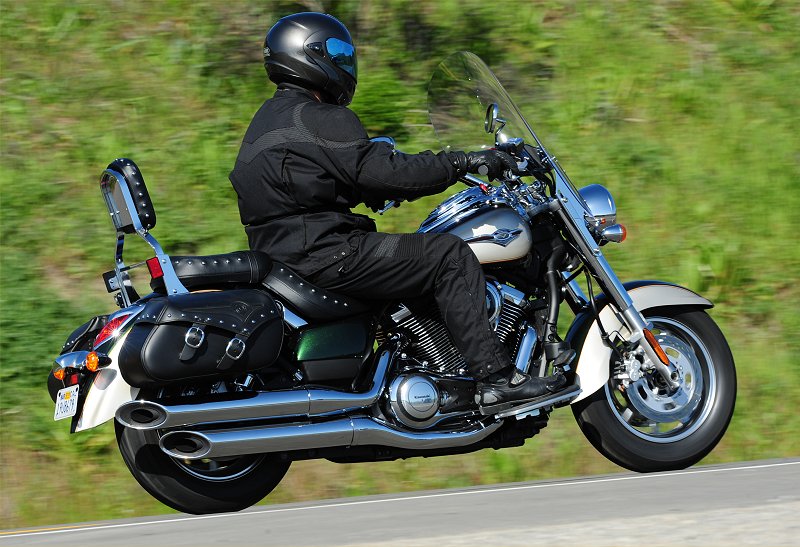
Vulcan 1700 Classic LT
Interestingly, Kawasaki moved the powerband around on the various models. The “touring” models, including the Nomad and the Voyager, make their peak horsepower at 5000 rpm (vs. 4500 rpm on the Classic models) and 108 foot pounds of torque at 2750 rpm (vs. that same peak at 2250 rpm on the Classic models).
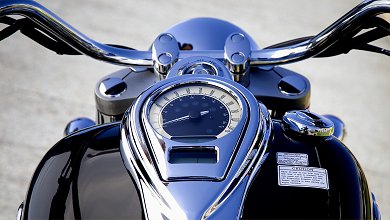
Although the Vulcan 1600 was hardly criticized for poor handling (we thought it handled quite well, actually), Kawasaki really tried to move the goal posts with its new chassis. A massive 40% more rigid than the old frame, that new chassis is also more compact. A shorter wheelbase combines with tweaked steering geometry to improve, according to Kawasaki, both stability and turning. The chassis also allows more compact ergonomics, including a 30mm shorter reach to the handlebar, and a 50mm shorter reach from the seat to the floorboards.
The 43mm inverted front forks are non-adjustable, while the rear shocks allow adjustment of air pressure (from a stock 0 psi to 43 psi) and four-way rebound damping.
New styling utilizes genuine, steel fenders, and incorporates a large, 5.3 gallon fuel tank. All of the bikes (save the Voyager) have traditional gas tank mounted instrumentation that incorporates a fuel gauge, fuel consumption read-out (including range to empty and average mpg) odometer, clock, two trip meters and a gear position indicator. The ignition, together with an integrated fork lock, is mounted conveniently near the steering head.
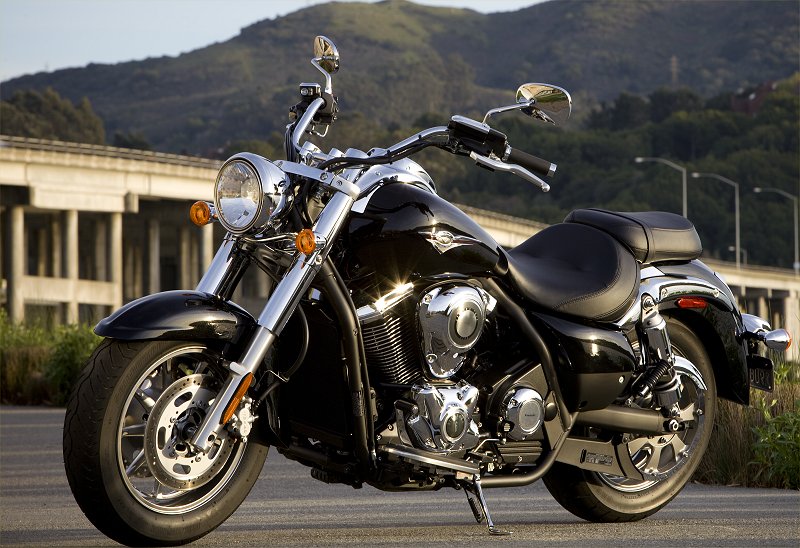
Vulcan 1700 Classic
Incorporating all these features is the simple Classic model, available only in Metallic Diablo Black at a U.S. MSRP of $12,299. The Classic LT, on the other hand, adds standard two-tone paint, height adjustable windshield, studded seats, and passenger backrest. The LT also gets leather saddle bags that are reinforced in certain areas to better hold their shape and improve functionality. Paint schemes available for the LT include Metallic Nocturne Blue/Pearl Burnish Beige and Metallic Dark Green/Pearl Burnish Beige. U.S. MSRP is $13,799, and Kawasaki points out that adding the LT accessories to the Classic would cost you approximately $1,200 more than the price of the LT.
Next Page >> | 1 | 2





